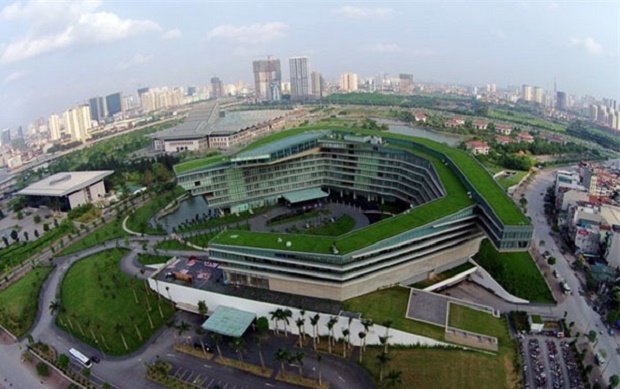Main Types and Key Functions of Green Roofs

Green roofs are essentially a growing medium and vegetation surface applied to a waterproofing layer of a suitable conventional roof build-up. Generally speaking, there are three main types of green roofs: intensive, semi-intensive and extensive (including biodiverse). These definitions denote the amount of input required in terms of irrigation, nutrients and maintenance to keep the green roof flourishing.
Intensive green roofs, therefore, tend to be well manicured and need significant input, whereas extensive roofs need only minimal input.
Water and sustainable drainage
In countries such as Austria, Switzerland and Germany, green roofs are recognised as a significant source-control component,contributing to storm water management and pollution control. For example, in many German cities businesses receive a rebate in their storm water charges if they have a green roof
Green roofs not only store water at roof level, but also reduce the run-off rate from the roof, which in turn reduces the underground drainage requirements. It is also possible to use or harvest rainfall from a green roof, although the amount of rainwater that can be used may be reduced depending on the type of green roof implemented. Water can also appear discoloured at first, though there are established methods of dealing with this discolouration
Thermal performance
Green roofs also significantly enhance the thermal performance and comfort of buildings, particularly in terms of summer cooling. Studies in North America have shown that an average of 4.15kWhr/m2 can be saved during the summer months. This impressive performance can also reduce the need for expensive air conditioning equipment and associated energy costs. A prime example of this is a small London café – Paradise Park – where it was calculated that no air conditioning units were needed for the offices beneath a green roof, providing an annual saving of 3,800kWhrs per year and significant financial savings as a result.
Green roofs do provide some additional insulation; however, this varies year-on-year depending on how dry or wet a given winter is. In Germany though, recent studies have shown that a 100mm green roof system can lead to savings of between 2-6kW/ m2 per year on winter energy bills. This variance is dependent on the amount of rainfall throughout the winter in any given year
Biodiversity
Any green space will provide intrinsic value to biodiversity and, as such, increasing biodiversity has been a key driver for green roofs in parts of the UK, especially London and Sheffield. To achieve optimum biodiversity there is a need to look at the type of green roof build-up (the substrates) and vegetation or flowers to be used. Research in both Switzerland and the UK has demonstrated that using various substrate depths and planting with sedums and herbs can increase the benefit of green roofs to rare invertebrate populations. What is more, the use of semi-intensive and intensive green roofs can provide an array of advantages for many common – and in some cases rare – species within the national, regional and local biodiversity action plans. Greater substrate depths will also aid storm water management and the building’s thermal performance
Sound insulation
A further advantage of green roofs is that they provide superior sound insulation compared to more traditional roof coverings. While there is no research in the UK or Europe at present to support this, recent studies in North America demonstrate the increased sound insulation they offer and, therefore, the decreased need for sound insulation or soundproofing on ceilings to reduce the amount of sound penetrating a building. With soundproofing an increasingly important design consideration in a school’s construction, as well as a key stipulation in the DCSF’s guidance document ‘Standard Specifications, Layouts and Dimensions’ (SSLD document five), this is clearly a major advantage
Health and safety
Ensuring safe access to the roof, as well as safety whilst on it, are also key issues that need to be addressed at design stage. In particular, consideration should be given to which areas of the roof need to be accessed by students and teachers and where the green roof is situated in relation to other surrounding roof areas. Other considerations will be dictated by the age of the students accessing the roof. However, by meeting these health and safety requirements, schools often find a green roof brings unexpected health and safety benefits – for example, a reduction in insurance costs for field trips together with a reduction in associated parental-approval paperwork.
Additional benefits of Green Roofs
Other key benefits occur when green roofs are applied to waterproofing, providing protection from frost, UV light and other climatic factors, and thus increasing the life of a building’s membranes. The provision of appropriately designed landscape at roof level can also create valuable amenity areas within buildings, providing space for outdoor classrooms and other educational activities – a benefit that is largely ignored at present.